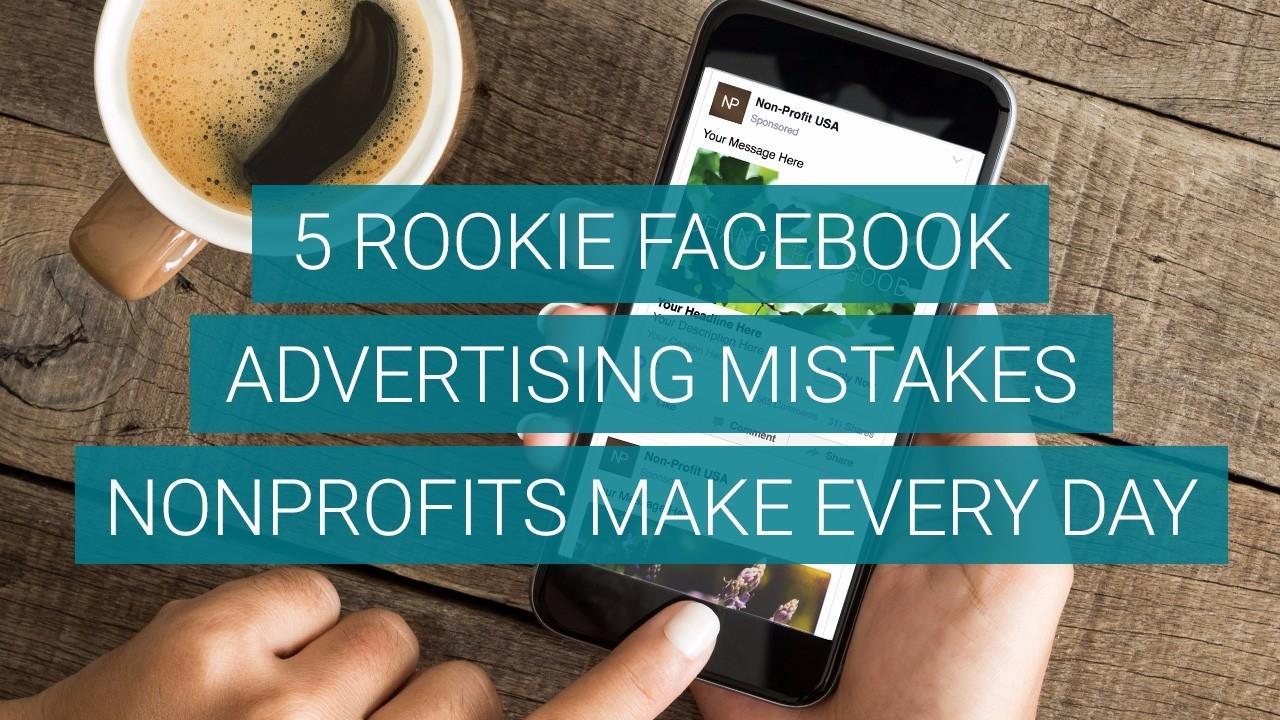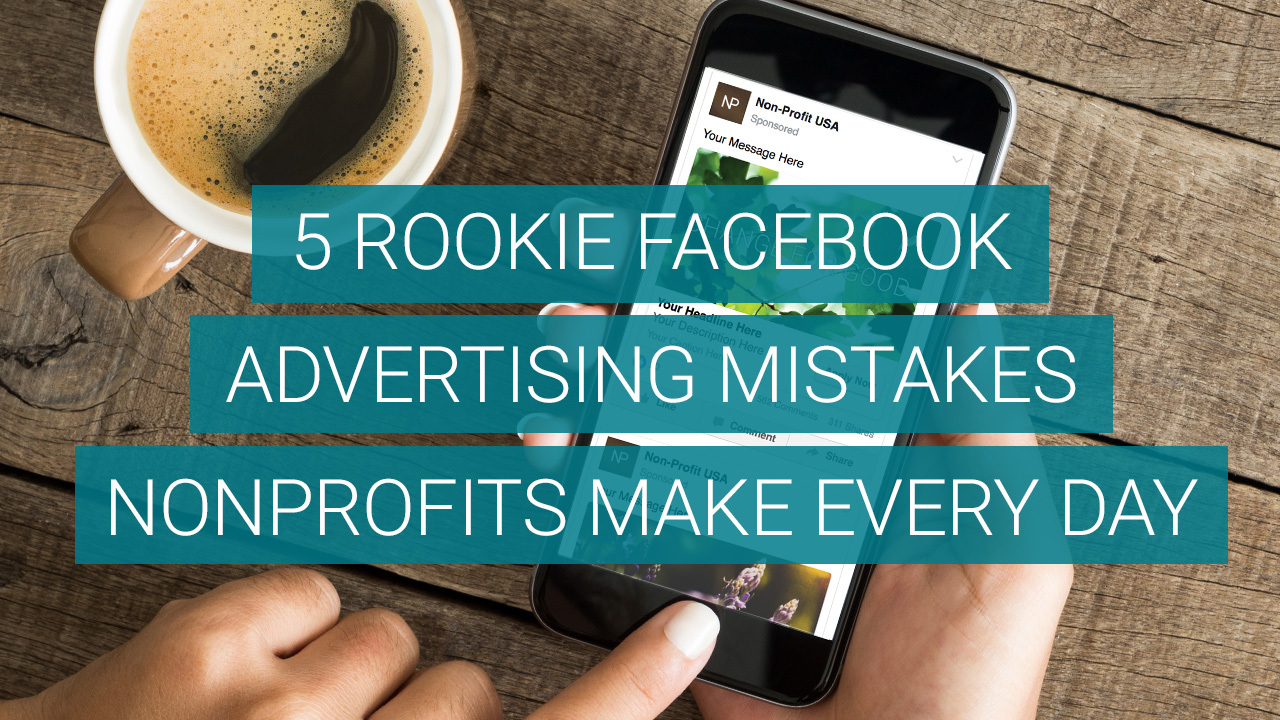5 Rookie Facebook Advertising Mistakes Nonprofits Make Every Day
Mar 21, 2017
In the past few years, nonprofit organizations have used Facebook advertising as part of their marketing outreach strategy. It’s a good thing! In fact, we’ve helped many of our clients formulate and execute Facebook advertising plans for things like end-of-year contribution campaigns, special events, and calls for volunteers.
As we all know, social media strategies are ever-changing and fast-moving. Nonprofits, however, are often slow to change or to adjust their marketing efforts, primarily due to time and staff limitations.
I totally get it! They are do-gooders; doing good in the world, busy with the day-to-day work they are so passionate about and therefore little time to think about marketing, let alone research or time to stay in the know with current Facebook advertising trends. That’s why I wanted to share these rookie Facebook advertising mistakes with you here. I've also included some resources that will quickly keep you in the know so you can: #1, avoid the non-profit rookie route to Facebook advertising; and #2, be sure to use your nonprofit marketing and advertising time and money wisely so that you get the best return on your invest. I know that’s super important for all our non-profits clients and friends.
So let’s dive in!
 Facebook Advertising Mistakes Not To Make
Facebook Advertising Mistakes Not To Make
#1. Boost and Be Done
Boosters beware! It is a waste of money.
Don’t believe me? Facebook promoted posts, or boosts, seem like the least complicated way to “advertise” on Facebook. They seemingly offer nonprofits like yours a quick way to reach more users with your Facebook posts for a nominal investment. However, Facebook advertising has evolved and the organic reach of boosted Facebook posts has declined. Not the best use of your marketing dollars!
Why it’s working against you, not for you
It’s simple really. The goal of boosting your Facebook posts is not to just engage or increase their reach, but to convert those who just sees your post to those who would go to your website. But when you boost post, Facebook will only optimize it for more engagement (i.e. likes, shares, and comments.). Link clicks are more valuable than your number of likes. Although the engagement makes you feel good (more likes, shares and comments), it’s not optimized to give you a good return on invest. My advice at this point in time is to avoid boosting. Facebook has so much more advertising power that is a much wiser investment.
#2. No Ad So Sad
Grab and keep their attention.
Ads create a social connection needed for users to engage with your mission. They are incredibly powerful tools. Today, more and more of the people you want to engage have shifted to mobile over desktop—a market that Facebook now monopolizes.
In the world of social media—where interested people are looking for “good things” to support and tell others about too—photos and videos help tell your story. They enhance and visually communicate what you do and why you do what you do. Using Facebook Ads are not only a great way to visually communicate your mission; they also let you target audiences that are most likely to respond to your ad. It’s a double dose of advertising power that shouldn’t be overlooked.
#3. No Aim No Audience
Don’t advertise willy-nilly.
You want to carefully select your audience, and Facebook advertising allows you to do just that. It is the perfect opportunity to get in front of those who are most likely to support your mission based on what Facebook knows about them. Through Facebook’s robust algorithms, you can easily aim your marketing towards specific demographics (age and gender, for example), connections (through who already “likes” your page and their friends), and interests (movies, games, sports, shopping, and music, for example).
#4. Conversion Confusion
Missed them the first time around? No worries. Facebook has a way around that.
Redirecting or remarketing keeps your brand in front of bounced traffic even after they have left your website. Be proactive! Rethink targeting strategies for those who have looked around a bit but haven’t decided if they want to engage. You know how it goes. Sometimes it takes a little time to decide if you want to engage, support or buy what is being offered.
How does this work? Adding a small, unobtrusive piece of code (or pixel) on your website sends an anonymous browser cookie when a new user visits your website. Then, when those same users browse the Internet, that cookie will place your ad only to those people who have visited your site before, recapturing their interest. This is effective because it retargets your advertising on people who have already demonstrated interest. So very clever don’t you think? Remember, your conversion rate is where the effectiveness of your advertising is measured. Facebook provides endless ways to modify and adjust targeting so you can find the best audience to get in front of, the ones that respond to your ads and thereby make advertising worth the investment.
#5. Who, What, When? I don’t know, let’s do it again.
Metrics matter.
They really do! How else will you track the progress, or lack thereof, of your Facebook advertising strategies? Every post or ad that you send out has metrics or analytics attached to it. Don’t underestimate their value.
Unlike traditional print ads or direct mail campaigns, you can measure the effectiveness of Facebook ads. Facebook Insights is a free tool that will tell you a lot about your ad’s social impact. These detailed numbers break down the user engagement percentage, the number of likes and shares, who liked it, and how many. It also compares those numbers with last week’s numbers.
Oh, the places your advertising efforts will go!
Heed these tips so that you bypass those common rookie Facebook advertising mistakes. Stay in the know as social media continues to shift and change, as we all know it will!

